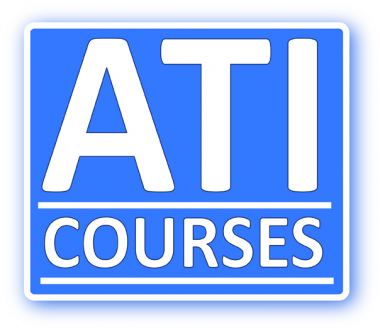ATI Strapdown Inertial Navigation Systems Course
In this highly structured four-day short course - specifically tailored to the needs of busy engineers, scientists, managers, and aerospace professionals - Logsdon will provide you with cogent instruction on the modern guidance, navigation, and control techniques now being perfected at key research centers around the world.
The various topics are amply illustrated with powerful analogies, full-color sketches, block diagrams, simple one-page derivations highlighting their salient features, and numerical examples that employ inputs from battlefield rockets, satellites, and deep-space missions. These lessons are carefully laid out to help you design and implement practical performance-optimal missions and test procedures.
- Inertial Navigation Systems. Fundamental Concepts. Pendulum Errors. Strapdown Implementations. Ring Laser Gyros. The Sagnac Effect. Monolithic Ring Laser Gyros. Fiber Optic Gyros. Advanced Strapdown Concepts.
- Radionavigations's Precise Position-Fixing Techniques. Active and Passive Radionavigation Systems. Precise Pseudoranging Solutions. Nanosecond Timing Accuracies. The Quantum-Mechanical Principles of Cesium and Rubidium Atomic Clocks. Solving for the User's Position.
- Integrated Navigation Systems. Modern INS Concepts. Gimballing and Strapdown Implementations in Review. Embedded Navigation Systems. Open-Loop and Closed-Loop Implementations. Chassis-Level Integration. Transfer Alignment Techniques. Kalman Filters and Their State Variable Selections. Real-World Test Results.
- Hardware Units for INS Inertial Navigation. Sensors. Solid-State Accelerometers. Initializing Today's Strapdown Inertial Navigation Systems. Coordinate Rotations and Direction Cosine Matrices. Advanced Strapdown Concepts and Hardware Units. Strapdown INS Launched Into Space.
- Military Applications of Integrated Navigation Systems. Developing and Implementing the Worldwide Common Grid. Translator Implementations at Military Test Ranges. Military Performance Specifications. Military Test Results. Tactical Applications. The Trident Accuracy Improvement Program. Tomahawk Cruise Missile Upgrades. SLAM Missile.
- Navigation Solutions & Kalman Filtering Techniques. P-Code Navigation Solutions. Solving For the User's Velocity. Evaluating the Geometrical Dilution of Position. Deriving Real-Time Accuracy Estimates. Kalman Filtering Procedures. The Covariance Matrices and Their Physical Interpretations. Typical State Variable Selections. Monte Carlo Simulations.
- Smart Bombs, Guided Missiles, & Artillery Projectiles. Beam-Riders and Their Destructive Potential. Smart Bombs and Their Demonstrated Accuracies. Smart and Rugged Artillery Projectiles. The Paveway IV.
- Spacecraft Subsystems GPS Subsystems on Parade. Orbit Injection and TT&C. Electrical Power and Attitude and Velocity Control. Navigation and Reaction Control. Schematic Overview Featuring Some of the More Important Subsystem Interactions.
- Spaceborne Applications of Integrated Navigation Systems. On-Orbit Position-Fixing for the Landsat Satellites. Highly Precise, Orbit-Determination Techniques. The Twin Grace Satellites Guiding Tomorrow's Booster Rockets. Attitude Determination for the International Space Station. Cesium Fountain Clocks in Outer Space. Relativistic Corrections for Radionavigation Satellites.
- Guidance & Control for Deep Space Missions. Putting ICBM's Through Their Paces. Guiding Tomorrow's Highly Demanding Missions from the Earth to Mars. JPL's Awesome New Interplanetary Pinball Machines. JPL's Deep Space Network. Autonomous Robots Swarming Through the Universe. Unpaved Freeways in the Sky.
- What are the key differences between gimballing and strapdown Inertial Navigation Systems?
- How are transfer alignment operations currently being carried out on the modern battlefield?
- How sensitive are today's solid state accelerometers and how are they currently being designed?
- What is a covariance matrix and how can it be used in evaluating the performance capabilities of Integrated GPS/INS Navigation Systems?
- How does the Paveway IV differ from its predecessors?
- What are its key performance capabilities on the battlefield?
- What is the deep space network and how does it perform its demanding mission assignments?
Speaker and Presenter Information
Thomas S. Logsdon has accumulated more than 30 years experience with the Naval Ordinance Laboratory, McDonnell Douglas, Lockheed Martin, Boeing Aerospace, and Rockwell International. His research projects and consulting assignments have included the Tartar and Talos shipboard missiles, Project Skylab, and various interplanetary missions. Mr. Logsdon has also worked on the Navstar GPS project, including military applications, constellation design and coverage studies. He has taught and lectured in 31 different countries on six continents and he has written and published 1.7 million words, including 29 technical books. His textbooks include Striking It Rich in Space, Understanding the Navstar, Mobile Communication Satellites, and Orbital Mechanics: Theory and Applications.Relevant Government Agencies
Air Force, Army, Navy & Marine Corps, Intelligence Agencies, DOD & Military, Office of the President (includes OMB), Dept of Homeland Security, Dept of the Interior, Dept of State, NASA, Other Federal Agencies, CIA
This event has no exhibitor/sponsor opportunities
When
Mon-Thu, Jan 17-20, 2011, 8:30am - 4:30pm
Where
Holiday Inn
15101 Sweitzer Ln.
Laurel, MD
Get directions
Website
Click here to visit event website
Organizer
ATI Courses






